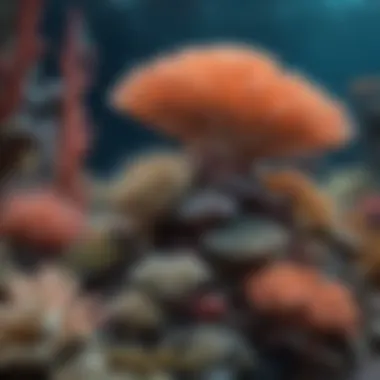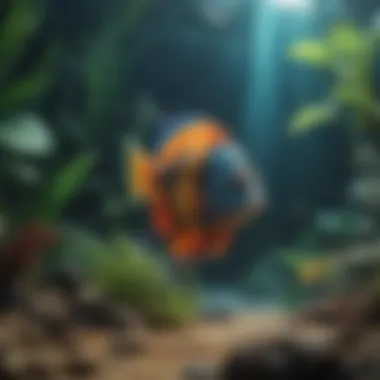Exploring Caribbean Waters: Biodiversity and Conservation


Intro
The Caribbean waters represent a unique ecosystem characterized by their diverse marine life and ecological importance. These waters are home to a rich array of species, each playing a vital role in maintaining the ecological balance of the region. In this article, we explore the various dimensions of Caribbean waters, emphasizing their biological richness alongside cultural and economic impacts.
As we delve into these aquatic environments, it is important to acknowledge both their beauty and the challenges they face. Factors such as climate change, pollution, and overfishing significantly threaten these ecosystems. Understanding the complexities of Caribbean waters leads to a deeper appreciation of their intrinsic value and the necessity for effective conservation efforts.
Animal Overview
Common Name and Scientific Classification
The Caribbean hosts a rich diversity of marine animals. Notable examples include the bottlenose dolphin (Tursiops truncatus), the Caribbean reef shark (Carcharhinus perezi), and the hawksbill sea turtle (Eretmochelys imbricata). These organisms vary widely in their biological classifications, with some belonging to different phyla such as Chordata and Mollusca.
Physical Characteristics
Each species showcases unique physical traits adapted to their specific habitats. For instance, the bottlenose dolphin has a streamlined body, enabling swift movement through water, while the hawksbill sea turtle, with its distinct shell and beak shape, excels in foraging for sponges and other marine organisms.
Habitat and Distribution
Caribbean marine life can be found in various habitats including coral reefs, mangroves, and seagrass beds. The coral reefs are particularly significant, serving as a breeding ground for many species and providing essential shelter. These habitats are distributed across islands and coastal waters, each playing a fundamental role in the marine ecosystem.
Behavior and Social Structure
Communication Methods
Marine animals in the Caribbean employ various communication methods. Dolphins use a complex system of clicks and whistles, while other species may rely on visual signals or chemical cues to interact with one another.
Social Hierarchies
Social structure among species varies. For instance, dolphins are known to form pods, often displaying intricate social hierarchies based on age and rank. This contrasts with solitary predators like the Caribbean reef shark, which usually hunt alone or in small groups.
Mating and Reproductive Behavior
Mating behaviors also differ across species. The hawksbill sea turtle, for example, exhibits nesting behaviors where females return to specific beaches to lay eggs each year, while dolphins showcase courtship displays involving acrobatics and vocalizations.
Conservation Status
Current Population Trends
Many species within the Caribbean face declining populations. Overfishing, habitat destruction, and climate change greatly impact these trends. Monitoring efforts are crucial to understanding these dynamics.
Threats and Challenges
The threats to Caribbean marine life are numerous. Marine pollution, including plastics and chemicals, degrades habitats and poses risks to animal health. Additionally, rising sea temperatures and ocean acidification threaten coral reefs, which are critical to marine biodiversity.
Conservation Efforts and Success Stories
Various conservation initiatives have emerged to address these challenges. Organizations like the Coral Triangle Initiative focus on protecting marine environments and restoring ecosystems. Success stories include the restoration of certain reef areas, demonstrating that proactive steps can lead to positive outcomes.
Understanding and protecting Caribbean waters is not just vital for the marine species that inhabit them, but also for the local communities that rely on these ecosystems for their livelihoods and cultural heritage.
This comprehensive exploration of Caribbean waters emphasizes the intricate link between marine biodiversity, ecological health, and conservation. The insights gained here can inspire informed action, ensuring a balanced relationship between humans and the marine world.
Preface to Caribbean Waters
The Caribbean waters hold profound ecological, cultural, and economic significance. These waters serve as a vital ecosystem, supporting an impressive array of marine life. Acknowledging the importance of Caribbean waters allows for a deeper understanding of their role in the global environment. The unique characteristics of the Caribbean, from its geographic layout to its diverse biological communities, merit close examination. All of these elements are interlinked, contributing to the health of global marine systems.
This exploration will offer insights into the various aspects of Caribbean waters, including their geographical layout and historical background. The geographical overview will discuss not only the physical features but also the connectivity between islands and oceanic currents. This lays the groundwork for understanding the ecological dynamics at play. The historical context will reflect on human interactions with these waters throughout history, revealing long-standing patterns of utilization and conservation.
Understanding these nuances is essential for stakeholders, including policymakers, conservationists, and local communities. Such awareness fosters informed decisions to preserve these waters for future generations. By studying the intricacies of Caribbean waters, we can appreciate not only their beauty but also their indispensable roles in human life and nature.
Geographical Overview
The Caribbean Sea is enclosed by various landmasses, including islands and the coastline of Central and North America. It covers approximately 2.754 million square kilometers. The sea interacts with the Atlantic Ocean and is connected through channels. The Greater Antilles includes large islands like Cuba, Jamaica, and Hispaniola, while the Lesser Antilles comprises smaller islands, creating a diverse archipelago.


This geographical layout influences ocean currents, which play a critical role in regulating climate and marine life. The warm waters of the Caribbean are a result of tropical climate conditions. Furthermore, the presence of coral reefs along the coastlines affects marine biodiversity and serves as a barrier against strong waves.
Historical Context
The history of the Caribbean waters is rich and complex. Initially, the indigenous populations lived in harmony with the sea, relying on its resources for sustenance. The arrival of European explorers in the late 15th century marked a significant turning point, leading to colonization and exploitation of marine resources. Over time, fishing and trade developed into major industries, creating both economic opportunities and ecological challenges.
Colonial activities often overlooked the long-term impacts on marine ecosystems. The introduction of non-native species and overfishing altered the delicate balance of these waters. Understanding this historical backdrop is vital for current conservation efforts. It reminds us of the lessons learned from past mistakes and the need for sustainable practices moving forward.
Physical Characteristics
Understanding the physical characteristics of Caribbean waters is essential for grasping the ecological systems that thrive within this region. Various factors, such as water composition, temperature variations, and salinity levels, significantly influence marine life and the overall health of aquatic environments. These characteristics do not just shape the habitat; they also determine the behavior of countless species and the dynamics of entire ecosystems. Recognizing these elements provides valuable insight into both the opportunities and challenges that marine ecosystems face in a rapidly changing world.
Water Composition
The composition of water in the Caribbean is unlike any other region in the world. Generally, seawater consists mostly of hydrogen and oxygen, combined as O, but the Caribbean also contains various dissolved salts, minerals, and organic materials that contribute to its unique properties. Most notably, the high concentration of salts makes it brackish in certain areas, particularly near rivers and estuaries. These variations in composition greatly influence the biodiversity of the region.
Different marine organisms have adapted to thrive in specific compositions. For example, coral communities require a stable balance of calcium, magnesium, and bicarbonate to build their structures. Moreover, changes in composition can affect the availability of essential nutrients like nitrogen and phosphorus, thereby impacting phytoplankton, which forms the base of the marine food web.
Temperature Variations
Temperature is another crucial factor that illustrates the dynamic nature of Caribbean waters. Given the tropical geographical location, surface temperatures usually range from 23°C to 30°C. These variations can influence the breeding cycles of fish, migration patterns of marine mammals, and the resilience of coral reefs.
Moreover, temperature changes can lead to phenomena like thermal stratification. This process separates water layers based on their temperature, potentially reducing oxygen levels in lower layers. Such conditions might affect marine life by limiting their habitat and breeding grounds, consequently disrupting the intricate balance between different species.
Salinity Levels
Salinity, the measure of salt concentration in water, plays a significant role in the overall health of Caribbean marine life. It varies between regions and times of the year due to factors like precipitation, evaporation, and freshwater influx from rivers. Generally, salinity levels in Caribbean waters range from 32 to 38 parts per thousand.
Organisms in the Caribbean have adapted to these salinity levels. Euryhaline species, such as certain fish and invertebrates, can thrive in varying salinities, while stenohaline species are sensitive to changes and may only survive within a narrow salinity range. Fluctuations beyond the normal range can lead to stress and mortality in sensitive species, demonstrating how vital it is to monitor salinity levels for conservation efforts.
In summary, the physical characteristics of Caribbean waters are not static; they are influenced by various ecological and anthropogenic factors that can have lasting consequences for the marine environment.
Marine Biodiversity
Marine biodiversity is a crucial element of Caribbean waters, reflecting the rich ecological tapestry that these aquatic environments constitute. The diverse species present not only contribute to the beauty of the region but also serve essential roles within the ecosystem. Understanding this marine biodiversity helps to illustrate the complexity of interactions among various organisms, as well as their individual and collective significance to environmental health.
Coral Reefs
Structure and Function
Coral reefs serve as some of the most productive and diverse ecosystems on the planet. Their structure is built from calcium carbonate, which corals create. This structure provides habitats for a myriad of marine species. The physical complexity of coral reefs allows for a variety of niches, which support numerous fish and invertebrate species. The unique feature of coral reefs is their ability to provide shelter and breeding grounds, making them essential for fish populations and other marine life. However, they are also sensitive to environmental changes.
Threats to Coral Ecosystems
Coral ecosystems face several threats, primarily stemming from human activity and climate change. Significant factors include ocean acidification and rising sea temperatures, which compromise coral health. The role of these threats is vital to understanding the fragility of coral ecosystems. A key aspect is that they contribute to reducing the resilience of the reef, which can lead to wider environmental implications. Such threats highlight the urgent need for conservation efforts to mitigate their impacts.
Fish Species
Diversity of Species
The Caribbean is home to a wide variety of fish species, which adds to the richness of marine biodiversity. This diversity is beneficial as it maintains the balance within the ecosystem. Different species occupy various ecological roles, from herbivores grazing on algae to apex predators. The unique feature of this diversity is its resilience; a variety of species can ensure the stability of marine ecosystems in times of change or stress. However, such diversity also demands careful management to prevent overfishing and habitat destruction.
Importance of Fish Populations
Fish populations are important not only for their ecological roles but also for their economic significance. They support local economies through fishing and tourism. The key characteristic of these populations is their contribution to food security for many coastal communities. Additionally, healthy fish populations indicate a robust marine ecosystem. Recognizing the importance of sustainable fishing practices is essential for maintaining this balance and ensuring the longevity of marine resources.
Other Marine Life
Marine Mammals
Marine mammals, such as dolphins and manatees, play crucial roles in the ecosystem. Their presence often indicates the health of the marine environment. A notable aspect is that these mammals can help in understanding the broader ecological dynamics due to their high-level positions in the food chain. Their unique communication and social structures also make them fascinating subjects for study. However, they face threats from habitat loss and human activities, emphasizing the need for protective measures.
Sea Turtles


Sea turtles are another significant component of Caribbean marine life. They play key roles in maintaining the health of seagrass beds and coral reefs by grazing. The key characteristic of sea turtles is their long migratory patterns, which facilitate nutrient cycling across vast ocean areas. This unique feature highlights their importance in the marine ecosystem. Nevertheless, sea turtles face challenges such as habitat destruction and poaching, making their conservation critical in sustaining marine biodiversity.
Cultural and Economic Significance
The Caribbean waters carry immense cultural and economic significance. These waters are not only a home to diverse marine life but also crucial for local communities and economies. The interaction of culture and economy creates a complex relationship that influences people’s lives in many way.
Tourism
Impact on Local Economies
The tourism industry thrives in the Caribbean. It largely depends on the allure of the pristine beaches, vibrant marine life, and outdoor experiences. Local economies benefit significantly from this sector. It creates jobs directly and indirectly, supporting everything from hospitality to transportation. For instance, hotels, restaurants, and tour operators see marked revenue increases during the tourist season.
The key characteristic of this economic impact is its ability to create employment for many residents. High levels of tourist activity lead to a multiplication of economic benefits, providing a sustainable income for many families.
A unique feature of tourism's impact is its seasonal nature. While it boosts the economy during peak months, downturns occur in off-seasons. This fluctuation can make local economies vulnerable, illustrating the need for diversification.
Sustainable Tourism Practices
Sustainable tourism practices are becoming increasingly important in the Caribbean. They aim to balance the economic benefits of tourism with the need for environmental protection. Educating tourists about local ecosystems is one aspect of this approach. Encouraging visitors to respect marine life and habitats contributes to conservation efforts.
The key characteristic of sustainable tourism is that it promotes long-term ecological health. This benefits both the environment and local economies. By attracting responsible tourists, regions can maintain their appeal without overwhelming natural resources.
A unique feature of sustainable practices is their focus on community involvement. Local residents often guide tourists, sharing their expertise about ecological and cultural heritage. However, challenges include establishing clear guidelines for tourists to follow while minimizing their impact on sensitive ecosystems.
Fishing Communities
Traditional Practices
Traditional fishing practices hold substantial cultural significance. These methods have been passed down generations, maintaining a deep connection between local communities and the sea. Many families rely on these practices for their livelihoods. Small-scale fishing supports not only individual incomes but also local markets.
A key characteristic of traditional practices is their sustainability. Methods like net fishing ensure that marine populations remain stable. They often promote a symbiotic relationship between the community and marine ecosystems.
However, a unique feature of this approach can lead to challenges. Dependency on traditional practices can limit economic growth, as they may not meet increasing demand. This highlights the need for innovation within fishing methods while preserving culture.
Modern Challenges
Modern challenges pose significant threats to fishing communities. Environmental changes, overfishing, and legislative restrictions impact the way fishers operate. Climate change affects fish populations, while illegal fishing practices deplete resources.
A key characteristic of these challenges is their complexity. They require multifaceted solutions that engage community members and policymakers alike. As fish stocks decline, communities face tougher decisions about how to sustain their livelihoods.
A unique feature is the regulatory landscape that often struggles to keep pace with the realities on the ground. Local fishers may find themselves at odds with policies that do not consider the nuances of their traditional methods. This situation creates tension that needs resolution to protect both culture and economy efficiently.
Environmental Threats
Understanding the environmental threats to the Caribbean waters is crucial for comprehending the intricate dynamics of this region's ecosystem. These threats can lead to significant ecological deterioration, affecting marine biodiversity and local economies. As the Caribbean islands rely on healthy marine environments for tourism and fishing, recognizing these threats helps shape effective conservation strategies.
Climate Change
Rising Ocean Temperatures
Rising ocean temperatures represent a pressing issue for Caribbean waters, primarily driven by global climate change. This phenomenon not only alters marine habitats but also affects the physiological processes of marine organisms. Warmer waters can lead to shifts in species distributions, as many marine species seek cooler areas. This can disturb established ecosystems, leading to reductions in biodiversity.
A critical characteristic of rising temperatures is the potential for fish and other marine life to migrate towards the poles or to deeper waters. While this can temporarily benefit certain species, it may also lead to the decline of local fish populations that depend on specific temperature ranges. Therefore, understanding how temperature influences marine life adds layers to our knowledge about the environmental dynamics within Caribbean waters.
Coral Bleaching
Coral bleaching is another alarming aspect of climate change impacting the Caribbean. When sea temperatures rise, corals expel the symbiotic algae living within their tissues. This process leads to bleaching, leaving corals vulnerable to disease and mortality. Bleached corals can recover if the temperature returns to normal, but prolonged periods of stress often lead to catastrophic declines in coral health.
Coral reefs are vital for marine biodiversity. They provide habitat and food for numerous marine species. Thus, if bleaching continues unabated, it undermines the ecosystem stability in Caribbean waters. Highlighting coral bleaching underscores the tangible effects of climate change and the necessity of preventive measures to protect these invaluable ecosystems.
Pollution
Marine Debris


Marine debris poses a significant threat to Caribbean waters, with plastic pollution being a major concern. Items such as plastic bags, bottles, and other refuse can harm marine species that ingest them or become entangled in them. Pollution leads to physical and chemical changes in the marine environment, impacting the overall health of the ecosystem.
A key characteristic of marine debris is its persistence in the environment. Plastics can take centuries to break down, which means that the impacts of pollution can be long-lasting. Addressing the issue of marine debris is essential for maintaining the ecological balance in Caribbean waters.
Impact on Marine Life
The impact of pollution on marine life is profound and multifaceted. Contaminants from land runoff, including pesticides and heavy metals, can accumulate in the food web, affecting not only individual species but entire ecosystems. Additionally, pollutants can disrupt reproductive health and cause physical deformities in marine animals, affecting population dynamics.
A special feature of this impact is that some species are more vulnerable than others, creating a cascading effect in the ecosystem. Highlighting the consequences of pollution helps raise awareness of the urgent need for regulation and community action to protect marine life in the Caribbean.
Overfishing
Decline in Fish Stocks
Overfishing is a critical issue facing Caribbean waters, leading to significant declines in fish stocks. Unsustainable fishing practices have made it difficult for fish populations to recover, threatening the balance of marine ecosystems. This decline can disrupt local economies that depend on fishing for sustenance and income.
The characteristic of overfishing is its immediate and visible effects, often seen through dwindling catches and the collapse of fish stocks. Addressing this issue is vital for long-term ecological balance and sustainable fishing practices in the Caribbean.
Regulatory Challenges
Regulatory challenges are significant obstacles confronting efforts to combat overfishing. Enforcing fishing quotas and protecting breeding grounds requires cooperation among various stakeholders, including governments, local fishers, and environmental groups. Often, there is a lack of resources and commitment to enforce regulations effectively, allowing overfishing practices to continue.
A unique feature of these regulatory challenges is their complexity. They can differ from one island to another based on local laws and engagement levels of communities. The discussion surrounding regulatory issues stresses the importance of collaborative efforts in ensuring the sustainability of fish stocks in Caribbean waters.
Addressing environmental threats in the Caribbean waters is not only vital for marine health but also for the social and economic well-being of the communities that depend on these resources.
Conservation Efforts
Conservation efforts in the Caribbean waters play a vital role in safeguarding the delicate balance of marine ecosystems. These initiatives address numerous threats, such as climate change, pollution, and overfishing, ensuring that future generations can experience the biodiversity and beauty of this region. The importance of conservation cannot be overstated; it not only protects wildlife but also supports local economies reliant on marine resources.
Marine Protected Areas
Marine Protected Areas (MPAs) serve as sanctuary zones within the Caribbean waters. These areas are established to conserve marine life and limit human activities that can harm ecosystems, such as industrial fishing or coastal development. By restricting access and promoting sustainable practices, MPAs support the recovery of depleted fish populations and coral reefs. This approach promotes biodiversity, allowing various marine species to thrive, thus maintaining ecological balance.
Community Involvement
Local Initiatives
Local initiatives are crucial in empowering communities to take active roles in conservation. These programs engage residents in monitoring marine activities, participating in cleanup drives, or advocating for protective measures. A key characteristic of these local efforts is their capacity for generating awareness about the importance of preserving marine ecosystems. By involving individuals directly, these initiatives foster a sense of ownership and responsibility toward the environment. Unique features include localized knowledge, which can provide insights into sustainable practices that work best for specific areas. However, challenges arise when funding is limited or when communities lack access to training resources.
Education and Awareness Programs
Education and awareness programs are essential for informing communities about the significance of marine conservation. These programs focus on providing information about local ecosystems, explaining the repercussions of harmful practices, and promoting sustainable choices. The key characteristic of education initiatives is their ability to reach a wide audience, from school children to local fishermen. Its unique feature is that it fosters a culture of conservation, encouraging proactive behavior toward marine resources. However, the effectiveness of such programs often depends on continuous engagement and support, which can be challenging to maintain.
Policy and Governance
Regional Collaboration
Regional collaboration among Caribbean nations is vital for effective conservation. This cooperation allows countries to share resources, knowledge, and strategies while addressing marine ecosystem challenges collectively. A key characteristic of this collaboration is the blending of local and regional policies, creating a framework for accountability and support. The unique feature is that countries can leverage each other's strengths and experiences, expanding the impact of conservation efforts. However, challenges may include differing national priorities or political will among nations, which can hinder progress.
International Treaties
International treaties contribute significantly to marine conservation efforts by establishing legal frameworks that hold countries accountable for protecting marine environments. These treaties can promote global cooperation on issues like overfishing, pollution control, and habitat protection. A key characteristic of international agreements is their binding nature, compelling nations to implement specific regulations and standards. Unique features include the facilitation of funding and technical support from international bodies, enhancing local capabilities. Nevertheless, the effectiveness of treaties often depends on proper enforcement and the commitment of participating nations.
Finale
In understanding Caribbean waters, we recognize their immense ecological and cultural significance. This article sheds light on various aspects concerning marine life, environmental challenges, and conservation initiatives that are vital for sustaining these rich aquatic ecosystems.
Summary of Key Insights
The exploration of Caribbean waters reveals several crucial insights:
- Biodiversity: The Caribbean is home to a diverse range of organisms, from vibrant coral reefs to numerous fish species, all contributing to the ecological balance.
- Human Impact: Activities like fishing, tourism, and pollution have profound impacts on these marine environments. The health of this ecosystem is interconnected with human activities.
- Conservation: Initiatives to create Marine Protected Areas and educate communities are essential for sustaining the integrity of Caribbean waters. Local participation is critical in these efforts.
Future Directions for Research
Further research is essential for the ongoing conservation of Caribbean waters. Future studies may focus on:
- Climate Change Impacts: Investigating how changing ocean temperatures affect coral bleaching and biodiversity.
- Pollution Sources: Identifying and mitigating sources of marine debris and chemical contaminants.
- Sustainable Practices: Exploring sustainable fishing techniques and responsible tourism models that could minimize human impact while promoting economic benefits.







